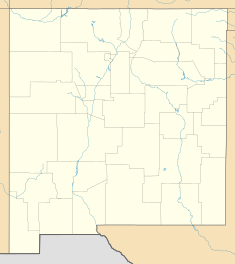McDonald Ranch House | |
 The McDonald-Schmidt Ranch House. The concrete box at the foot of the stone wall is the remnant of a 1984 time capsule, buried for 25 years on the completion of the home's restoration. | |
Location of McDonald Ranch House in southern New Mexico. | |
| Location | White Sands Missile Range |
|---|---|
| Nearest city | San Antonio, New Mexico |
| Coordinates | 33°39′2.66″N 106°27′37.28″W / 33.6507389°N 106.4603556°W |
| Built | 1913 |
| Part of | Trinity Site (ID66000493) |
| NRHP reference No. | 66000493 |
| NMSRCP No. | 30 |
| Significant dates | |
| Added to NRHP | October 15, 1966[2] |
| Designated NHLDCP | December 21, 1965[3] |
| Designated NMSRCP | December 20, 1968[1] |
The McDonald Ranch House in the Oscura Mountains of Socorro County, New Mexico, was the location of assembly of the world's first nuclear weapon. The active components of the Trinity test "gadget", a plutonium Fat Man-type bomb similar to that later dropped on Nagasaki, Japan, were assembled there on July 13, 1945. The completed bomb was winched up the test tower the following day and detonated on July 16, 1945, as the Trinity nuclear test.
The McDonald Ranch House was built in 1913 by Franz Schmidt, a German immigrant, and acquired by the McDonald family in the 1930s. The ranch was vacated by the McDonald family under protest in 1942, when the United States Army took over the land as part of the Alamogordo Bombing and Gunnery Range to use in training bomber crews during World War II.
The family hoped that the ranch would be returned after the war, but it was not, and in 1970, the Army announced that it would be kept permanently. The McDonald Ranch House was empty and deteriorating until 1982, when it was stabilized by the Army. In 1984 it was restored by the National Park Service to appear as it did on July 12, 1945. The site is now open to visitors twice a year, on the first Saturday in April and the third Saturday in October.

